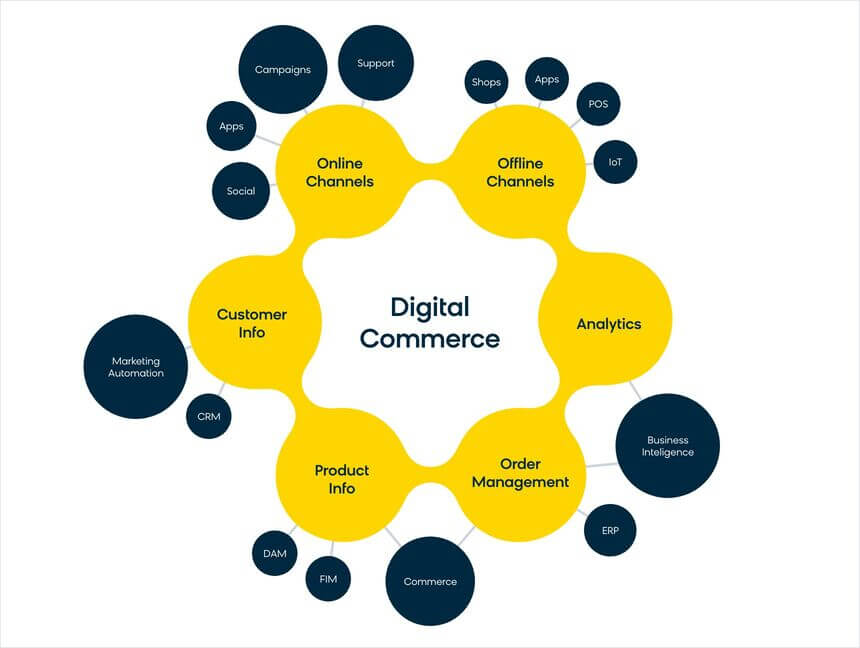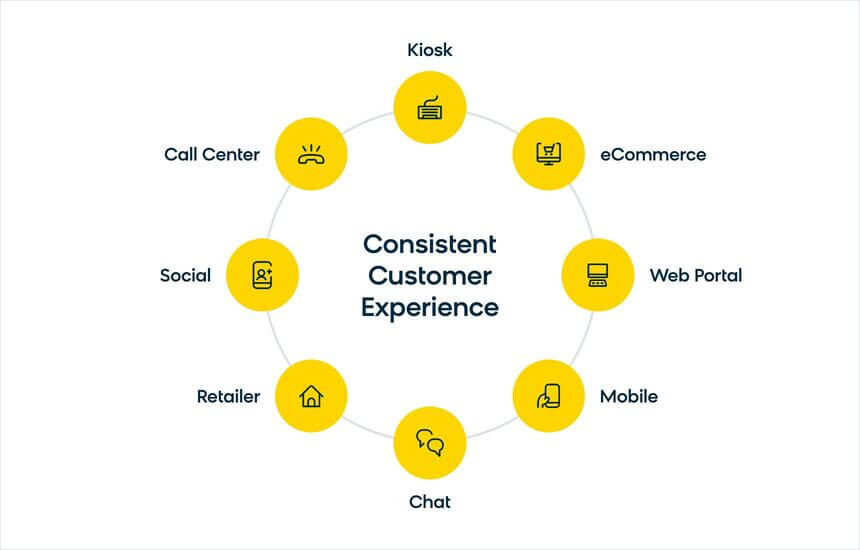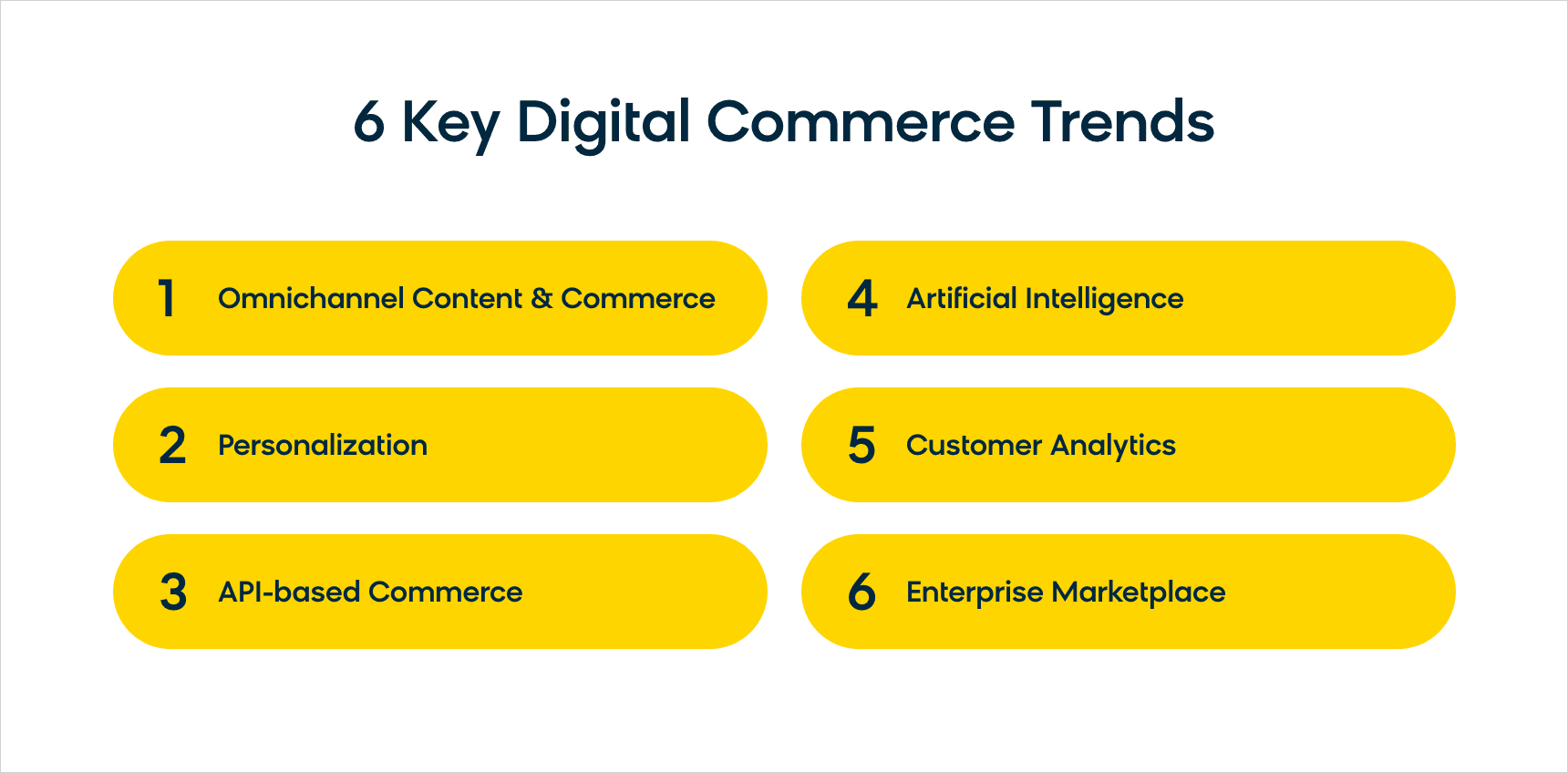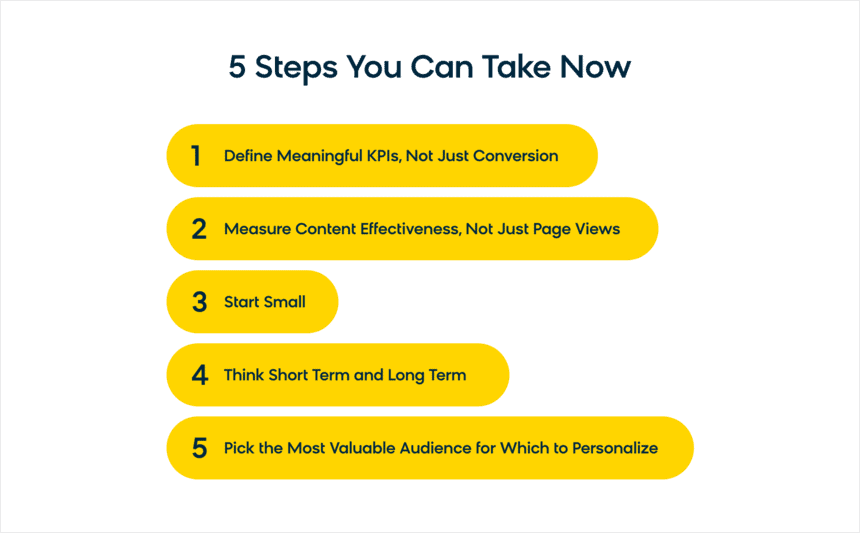Customer expectations can shift in an instant and digital commerce companies’ ability to adapt to market trends will determine their level of success in online retail. If you’re looking for a plan to navigate all the digital commerce changes and ecommerce trends shaping the marketplace today, keep reading to learn everything you need to know.
- Digital commerce is the buying and selling of goods and services using digital channels such as the internet, mobile networks, and commerce infrastructure.
- Digital commerce encompasses more than ecommerce because it’s also about creating touchpoints for the customer’s buying journey and working to craft the ideal connection between your audience and your brand.
- Creating a consistent customer experience across all touchpoints and understanding and remembering a customers’ interactions across those touchpoints will allow retailers to win with digital commerce..
What Is Digital Commerce?
Digital commerce is the buying and selling of goods and services using digital channels such as the internet, mobile networks, and commerce infrastructure.
Digital commerce includes:
- marketing activities that support these transactions, including people, processes, and technologies to execute the offering of development content
- analytics and promotion
- pricing
- customer acquisition and retention
- customer experience at all touchpoints throughout the customer buying journey
- digital marketing strategies
- social media marketing strategies
The Difference Between Digital Commerce and Ecommerce
Many people make the mistake of seeing ecommerce and digital commerce as interchangeable terms, but there is a key difference between the two.
Ecommerce is a simple, straightforward idea: It’s the practice of selling things online.
Digital commerce encompasses more than that. It’s about creating touchpoints for the customer’s buying journey and working to craft the ideal connection between your audience and your brand.
Where ecommerce is a method, digital commerce is a strategy. It’s a plan to give consumers an engaging, interactive experience and keep them coming back to patronize your business.
Why Is Digital Commerce Important?
As the impact of digitalization continues in both B2B and B2C, we’re seeing extreme changes in customer behaviors and expectations, including the way they research a product or service, consider and complete a purchase, show loyalty to a brand, and the way they communicate all of this to their peers.
The State Of Commerce Experience, a commissioned report conducted by Forrester Consulting on behalf of Bloomreach, found that in 2021, 83% of decision makers reported double-digit growth in digital revenue. In 2019, before COVID-19, only 9% experienced such growth.
This trend proves that digital commerce is so much more than a sales channel. It’s a way to cultivate a better and more profitable customer journey.
The online shopping experience has altered every step of the buying process, and brands need to adapt to this landscape. For example, according to that same study, 65% of customers research a product online before they go to the physical store.
All the signs point just how important digital commerce is — and there are three key areas to focus on to make your strategy the best it can be.
The Importance of Being Consistent
Creating a consistent customer experience across all touchpoints and understanding and remembering a customers’ interactions across those touchpoints remains important for retailers.
Consider something as basic as the ability, or inability, to save customers’ shopping baskets across all digital channels and devices.
This should be a given for modern brands, but many retailers still have gaps in their cross-touchpoint experience.
If your online experience isn’t saving recent searches and additions to shopping carts across devices and channels, especially when a customer is logged in, your digital commerce isn’t hitting the standards that every consumer expects from brands.
Why wouldn’t consumers expect to see items they placed in a basket on a mobile device when they sign in on a different device?
That kind of inconsistency makes it difficult to keep a customer engaged throughout the entire customer lifecycle — researching, buying, seeking support — when they are using multiple devices. Which they almost always are.
“The biggest challenge in digital commerce is to empower the organization to interlink and orchestrate all channels to create great customer experiences, without creating too much complexity.”
– Peter Zwyssig, CEO of foryouandyourcustomers
The Importance of Meeting Expectations
Keeping up with the surge of mobile and new digital devices being used by consumers is a challenge in itself.
Here are some statistics:
-
Studies show that 51% of website traffic comes from mobile devices.
-
Mobile transactions soared during Cyber Monday in 2020, with 64% of consumers using mobile to purchase products.
-
90% of buyers report that an excellent mobile experience is likely to convince them to make a repeat purchase from the same company.
Today, the focus for retailers should not only be on conversion or enabling sales on a particular device (smartphone, tablet etc.), but more on the influence their digital assets and presence have on overall sales (including those that are completed in store).
In fact, it’s predicted that 58% of retail sales will be influenced by digital in 2023. That’s why it’s vital to create a consistent digital experience that meets the growing expectations of your customers.
The Importance of Adapting to Digital Commerce in B2B
Traditionally, B2B has been lagging behind more innovative B2C organizations. But digital commerce is just as important in the B2B sector, and there are plenty of B2C digital commerce tactics that translate perfectly for modern B2B businesses.
The shift to a more online market in the last few years has been a wakeup call to all businesses to get their digital commerce strategy in order, amplifying the importance of customer experience and customer demands for better online experiences.
“The event has accelerated B2B ecommerce by at least two years,” says Brian Beck, Managing Partner at Enceiba, within a podcast episode on B2B commerce.
That’s why it’s wise for B2B enterprises to look at the lessons learned by the leaders in the B2C space.
“B2B companies need to leverage B2C shopping experiences, such as personalization, live chats, ratings, and reviews.”
– Jason Daiglar, Director at Gartner
Adopting such B2C practices will no doubt play a key role in shifting the mindset of B2B organizations.
And while pivoting to consumer-friendly B2B sites could put a strain on IT departments, B2B businesses need to start supporting new operating models and integrating new technologies into existing production and supply systems.
To further underscore that analysis, Gartner acknowledges that 70% of survey participants say that their organizations cannot keep up with the pace of change in digital commerce.
6 Key Digital Commerce Trends
Keeping up with digital commerce trends can be a daunting task in today’s fast-paced world, but there are a few areas that every business needs to focus on.
Omnichannel Content and Commerce
Digital commerce professionals need to create meaningful engagement with consumers in every channel.
Developing and serving the right content for the right place and time increases brand awareness and creates a consistent customer experience across channels.
It also maximizes the customer understanding that can be gathered from cross-channel analytics.
Personalization
Bloomreach defines ecommerce personalization as the practice of using commerce data responsibly to get to know, guide, and impress your customers with experiences that are so relevant and contextual, they feel like magic. Ecommerce personalization spans cross-channel, on-site, and in-app. It encompasses anonymous and known customers, and includes personalized messages, content, site layouts, products, and much more. It is driven by real-time, first-party data. This results in measurable journeys that engage and lead customers through brand awareness to product discovery to repeat purchases.
Personalization needs to be built into the core of the customer experience and impact every point of interaction.
Site search, browsing data, product recommendations, landing pages, and all other interaction points should work cohesively to build a complete picture of each visitor across their journey.
API-based Commerce
Legacy technology, along with inflexible commerce and content solutions, is holding enterprises back from building unique experiences and growing their business fast.
API-based commerce (aka headless commerce) circumvents these problems by using an API as the core to interface with separate business systems.
Instead of monolithic architecture, a lightweight API controls the transmission of data between systems — content, products, customer information, financials, and other systems reside in separate systems, free from any code that limits frontend development.
Retailers can enjoy the advantages of true omnichannel design by developing custom layouts in much less time than it takes a coupled system to accomplish the same feat.
This enables businesses to deliver relevant, contextual, and consistent product and content experiences to your customer across all the sites, apps, and other touchpoints they interact with.
Artificial Intelligence
Artificial intelligence is all the buzz in the digital commerce world right now. As you undoubtably have heard, AI is growing exponentially and isn’t showing any signs of slowing down.
AI applies advanced analysis and logic-based techniques — including machine learning — to interpret events, support and automate decisions, and take actions.
Some examples of AI in ecommerce include site search optimization, product recommendations, marketing automation, and shopping journey personalization.
Customer Analytics
We’ve learned a great deal since the term “big data” became a hot topic a decade ago. Today there are data-gathering practices and technologies that ensure good service while protecting everyone’s privacy.
And this is crucial for brands to get right, because analytics is the lifeblood of successful businesses. Truly enriching the customer experience requires marketers to step back and look at the different types of data they have. Then they should determine the data and technologies that provide customers with the kind of experiences they expect going forward.
Enterprise Marketplace
People don’t just expect convenience or better prices any more — that’s become a given. Now, they want options that take into account their tastes and preferences.
This means vendors and service providers need to start using customer data and analytics to fine-tune their services and compete in a fast-paced industry.
A marketplace that can aggregate various suppliers into logical bundles of services and products, which are then delivered to customers based on a detailed analysis and understanding of their preferences and priorities, is an intelligent marketplace delivering additional value to both merchants and users.
And if you aren’t already offering an above-and-beyond marketplace experience for your customers, your business is falling behind the times. By 2023, 15% of medium-to-high gross merchandise value digital commerce organizations will have deployed their own marketplaces, according to Gartner, thereby creating an entirely new digital ecosystem.
What Is a Digital Commerce Platform?
Digital commerce platforms are software solutions that empower customers to buy goods and services through an engaging, interactive, and self-service experience.
Essentially, they enable businesses to put into practice all the ideas we’ve laid out in this blog.
They do more than just the basic ecommerce fundamentals that offer customers a place to click and buy. They help your audience make their buying decisions and cultivate a meaningful relationship with your brand.
Digital commerce platforms include all the necessary components of ecommerce, including:
-
Online storefront setup capabilities
-
Product catalog navigation
-
Building and editing product pages
-
Creating shopping carts
-
Checkout and payment setup
-
Creating and maintaining customer accounts
But as we’ve noted, digital commerce also accounts for every important touchpoint of the entire customer journey. To incorporate all this, digital commerce platforms have many more features and capabilities, helping businesses build better customer experiences with:
-
Content marketing and promotional campaigns that incorporate multiple channels
-
Building product descriptions that interlink categories, collections, and themes
-
Advanced analytics and customizable dashboards
-
User experience mapping and journey orchestration
-
Customer service management
-
Order fulfillment and supply chain management
5 Steps You Can Take Now to Start With Digital Commerce [With Examples]
With so many trends, processes, and strategic approaches to consider, where should you start? Here are a handful of steps you can take today.
Define Meaningful KPIs, Not Just Conversion
When measuring the effectiveness of your efforts, it is very helpful to have multiple KPIs that actually tell you something about your customers and their behavior.
Obviously, conversion is an important KPI in any digital commerce environment. But variables like time spent on the site, the number of visits before conversion, and even the type of content visitors are consuming can also provide valuable insights in the overall journey and the visitor’s willingness to convert.
📌 [Example]: Customers looking at the cancellation page of a telecommunications company might be existing customers looking to cancel. But by looking at the overall journey, you could potentially identify if they looked at the store pages as well. It could be that visitors are concerned about their ability to cancel easily, but are still willing to sign up and buy.
Measure Content Effectiveness, Not Just Page Views
Measuring is a very logical next step. When we know the KPIs that are important, we can start looking at the actual content that contributes to them. That means looking beyond just visits to the store pages and really diving into the content that visitors consumed.
- Did they read the FAQ on payment options?
- Did they read the reviews on a product?
- Did they click the banner that said “Cancel Whenever?”
The data you’ll collect that way provides insight into which content works. It’s the sort of data you need to be able to experiment with content and see how it helps your KPIs.
Read this next: Why Unique Content Performs Better and How To Create Your Own [blog]
Start Small
As with all things, you will need to get started somewhere. And starting small is always much easier.
Don’t go for perfection immediately — be flexible and willing to learn.
📌 [Example]: Measuring content effectiveness is a very powerful tool, but it will take some time before things will be ironed out. So start by tagging content or investigating the data you have. That will provide some insight. With those insights, you can start making assumptions and testing them out. Being agile and patient will definitely pay off in the long term.
Think Short Term and Long Term
You should not be afraid to experiment and try out alternative solutions. The main lesson to keep in mind here is that nothing is ever finished.
In some cases, you might want to add a new solution to the existing infrastructure, while in others, you might want to take the lessons learned and implement those in the existing platform.
📌 [Example]: If you test out a new way of creating your campaign landing pages, you should also think about the long-term consequences of this structure. What do you gain in immediately? Are there any effects to consider for the future?
Pick the Most Valuable Audience for Which To Personalize
Just because you can personalize everything on your site for everyone in the universe does not mean you should.
While one-to-one personalization is talked about as the gold standard — and is highly desirable in many cases — think of personalization as a puzzle that requires all of the pieces to be put together to be most effective.
In some cases, segmentation and targeting is the wiser choice. It’s always helpful to try to weigh out the costs versus the benefits.
📌 [Example]: In the example mentioned earlier, we talked about the fact that people looking at cancellation options might be potential customers. It could be very interesting to try and convince those in this group to become a customer, but you should consider the bigger picture as well. If this is just 0.5 percent of the people on the site, you would probably be better off identifying a bigger audience. If it is 30 percent, things are very different.

Join the Companies That Are Driving the Digital Commerce Experience
For a truly transformative digital experience, you need to craft customer journeys that are so personalized, they feel like magic — which is exactly what Bloomreach offers.
Bloomreach has over 850 companies using our Discovery, Engagement, and Content products, resulting in hundreds of success stories and winning use cases in digital commerce.
Whether it’s My Jewellery winning with zero-party data or HD Supply increasing revenue from search, our Bloomreach Commerce Experience Cloud provides companies with innovative ways to own the digital commerce space.
The Bloomreach Commerce Experience Cloud combines content and experience management with market-leading, AI-driven search, merchandising, and personalization together in one efficient, modern platform.
Sound like something your business could use? Let us walk you through how Bloomreach can work for your organization.




















